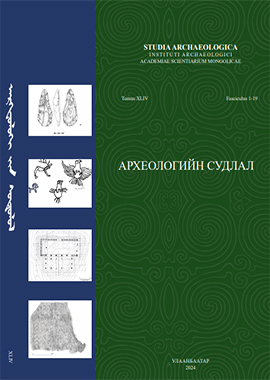About a paleoanthropological finding with spinal vertebrae disease
DOI:
https://doi.org/10.5564/sa.v44i1.3531Keywords:
Human bone, Colum spin, hunch back, spinal vertebraeAbstract
Grave No.3, which we are going to talk about, is located on the border between Ögiinuur and Battsengel sums of Arkhangai province, on the border between South Oortsog Mountain and Hevtee, on the north side of the Tamir River, on the local road to Battsengel sum, and the northern edge of the grave’s stone has lost its original shape. It is clear from the original state of the person and the accompanying findings that this tomb was completely intact. The person had been placed face up in a extend position, and the body of the lumbar and thoracic vertebrae of the person were tilted inwards and had lost their normality, indicating that the person had a hunched back. Hunchback can be caused by congenital or acquired diseases, and the owner of grave No.3, who participated in the study, had a congenital hunchback.
Багана нурууны эмгэг бүхий палеоантропологийн нэгэн олдворын тухай
Товчлол. Бидний өгүүлэх Дурсгал 3 нь Архангай аймгийн Өгийнуур, Батцэнгэл сумдын хил, Тамирын голын хойд талд байх урд Оорцог уул болон Хэвтээ хэмээх газрын заагт, орон нутгийн буюу Батцэнгэл сум хүрэх автозамд дараас чулууны хойд зах нь дайрагдаж анхны хэлбэрээ алдсан байдалтай байв. Энэхүү булш өмнө нь огт тоногдож хөндөгдөөгүй болохыг хүнээ анх тавьсан байдал болон дагалдуулан тавьсан эд зүйлсээс харж болохоор байна. Хүнийг дээш харуулан харуулан тэнэгэр байдалтай тавьсан байх ба уг хүний бүсэлхий, сээрний нугалмын их бие хэсэг дотогш ташуу болж хэвийн байдлаа алдсан эмгэг байгаа нь тухайн хүн бөгтөр нуруутай байсныг харуулж байгаа юм. Багана нуруу бөгтөр болох нь төрөлхийн болон олдмол мөн, өвчлөлөөс эхтэйгээр үүсэж болох энэхүү 3 дугаартай булшны эзэн багана нурууны эмгэгтэй байсан нь остеологи болон ажиглалт судалгааны үр дүнгээр батлагдаж байна.
Downloads
240
Downloads
Published
How to Cite
Issue
Section
License
Copyright (c) 2024 Erdene Batshatar

This work is licensed under a Creative Commons Attribution-NonCommercial 4.0 International License.
Copyright on any research article in the Studia archeologica is retained by the author(s).
The authors grant the Studia archeologica license to publish the article and identify itself as the original publisher.
![]()
Articles in the Studia archeologica are Open Access articles published under a Creative Commons Attribution-NonCommercial 4.0 International License - CC BY NC.
This license permits use, distribution and reproduction in any medium, provided the original work is properly cited.




